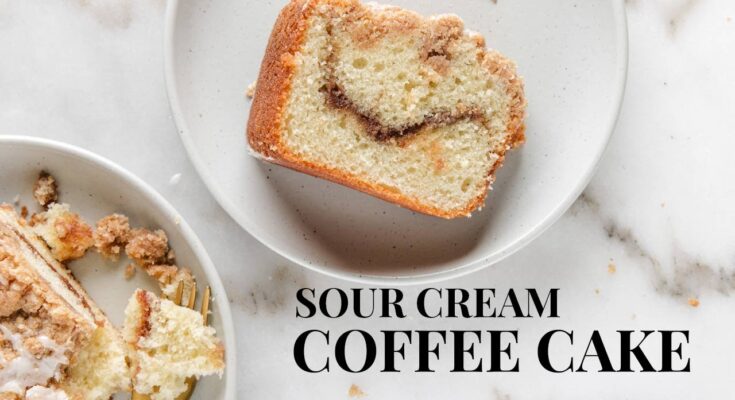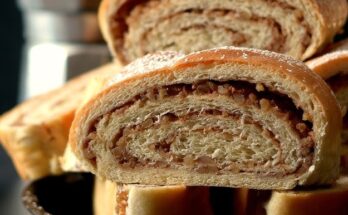Sour Cream Coffee Cake Recipe: There’s something deeply comforting about a fresh-baked coffee cake wafting through the house on a weekend morning. That warm cinnamon aroma, the rich crumb, the sweet streusel topping—pure joy in every bite. And when you add sour cream to the mix? It takes things to a whole new level. This is your ultimate guide to making a moist, fluffy, buttery Sour Cream Coffee Cake that will have everyone asking for seconds (and the recipe!).
Whether you’re whipping it up for brunch, a special occasion, or just because, this guide will walk you through every single step. No confusing techniques. No hard-to-find ingredients. Just foolproof instructions, helpful tips, and baking know-how to help you make the most delicious coffee cake of your life.
What Makes Sour Cream Coffee Cake So Special?
Let’s talk about why sour cream is the unsung hero in baking. Sour cream adds richness and moisture like no other ingredient can. It’s thick, creamy, slightly tangy—and it balances the sweetness of coffee cake in the best possible way.
Unlike milk or buttermilk, sour cream has a higher fat content, which means your cake turns out incredibly tender with a melt-in-your-mouth texture. And that tang? It cuts through the sweetness and gives the cake a depth of flavor that makes people wonder, “What’s your secret?”
Also, this cake is the perfect balance of dessert and breakfast. It’s not overly sweet, which means it pairs beautifully with your morning coffee or tea. But thanks to the buttery streusel topping, it still feels indulgent. It’s also the kind of recipe that looks impressive but doesn’t require you to be a pro baker. You’ll feel like a kitchen rockstar.
The History Behind Coffee Cakes
Coffee cake isn’t actually made with coffee (most of the time). The name comes from its purpose—being served alongside coffee. The concept of coffee cake dates back to Eastern and Central Europe. Immigrants brought over their sweet yeast-based pastries to the U.S., and over time, those recipes evolved into the sour cream-based versions we know and love today.
In the 1950s, baking with sour cream became popular in American kitchens. It added richness without the hassle of yeast. The streusel topping (a German touch) stuck around and became a beloved signature of coffee cake.
Fast forward to now, and the sour cream coffee cake has become a timeless classic—comfort food at its finest.
Ingredients You’ll Need
Getting the ingredients right is the first step to nailing this recipe. The beauty of this cake lies in its simplicity—basic pantry staples come together to make something magical. Here’s what you’ll need:
Dry Ingredients
- All-Purpose Flour – This is your base. Stick with plain flour for the right texture.
- Granulated Sugar – Sweetens the batter and balances the tang of the sour cream.
- Brown Sugar – Gives the streusel that classic caramelized flavor.
- Baking Powder + Baking Soda – These ensure the cake rises perfectly and has that light, fluffy crumb.
- Salt – A pinch enhances all the other flavors and keeps the cake from tasting flat.
- Cinnamon – The heart of the streusel topping. Warm, sweet, and cozy.
Wet Ingredients
- Unsalted Butter – Rich, creamy, and perfect for both the batter and the crumb topping.
- Eggs – Provide structure and richness. Make sure they’re at room temperature.
- Vanilla Extract – Adds a lovely depth of flavor.
- Sour Cream – The star ingredient! Use full-fat for the best texture and taste.
Streusel Topping Components
- Brown Sugar – For that caramelized crunch.
- Flour – Helps create those delicious clumps of crumb.
- Butter – Melted or soft, this binds it all together.
- Cinnamon – Gives that signature spice.
Optional Add-ins and Variations
- Chopped Nuts – Walnuts or pecans add a satisfying crunch.
- Fruit – Blueberries or diced apples work beautifully.
- Chocolate Chips – For those who want to go decadent.
- Nutmeg or Cardamom – Add a spice twist to the streusel.
Pro tip: Use high-quality ingredients—especially the vanilla and butter. It makes a big difference in taste.
Essential Tools for Baking
Must-Have Baking Tools
You don’t need fancy equipment, but a few essentials will make the process smoother and ensure better results.
- Mixing Bowls – At least two: one for dry, one for wet ingredients.
- Hand or Stand Mixer – Creaming butter and sugar by hand is tough work. A mixer makes it easier and ensures fluffiness.
- Measuring Cups and Spoons – Precision matters in baking.
- 9×13 Pan or Bundt Pan – Both work, depending on your desired shape.
- Rubber Spatula – Great for scraping down the sides of bowls and folding ingredients.
Nice-to-Have Extras for Better Results
- Offset Spatula – Helps spread the batter evenly.
- Pastry Cutter – For blending streusel if you’re not using your hands.
- Cooling Rack – Allows your cake to cool evenly without getting soggy on the bottom.
- Parchment Paper – Makes cleanup easier and prevents sticking.
Having these tools on hand doesn’t just make baking easier—it makes it more fun. And if you’re a beginner, don’t worry. Even a basic setup will get you a great result.
Preparing the Ingredients
Measuring Accurately for Perfect Results
Baking is a science. A little too much flour or too little sugar can throw everything off. Always spoon and level your flour into measuring cups instead of scooping it directly from the bag—it prevents overpacking and a dry cake. Use a kitchen scale if you want ultimate precision.
Measure liquids at eye level in a clear measuring cup. Level off dry ingredients with a straight edge (like the back of a butter knife). Don’t eyeball measurements—especially baking soda and powder.
Room Temperature Ingredients – Why They Matter
This might sound like a minor detail, but it’s a game changer. Room temp ingredients mix more evenly and trap more air during creaming, resulting in a light, fluffy cake.
- Butter should be soft enough to press your finger into, but not melty.
- Eggs should sit out for 30 minutes.
- Sour cream can be cold, but bringing it closer to room temp helps it blend better.
Cold ingredients won’t ruin your cake, but room temperature ones will make it better—richer, fluffier, and more uniform.
Step-by-Step Guide to Making Sour Cream Coffee Cake
Let’s roll up our sleeves and get baking. This part will walk you through every step, from preheating the oven to slicing the final piece of warm, delicious coffee cake. Follow these steps carefully and you’ll have a perfect cake every single time.
Step 1: Preheat the Oven and Prepare Your Pan
Begin by preheating your oven to 350°F (175°C). Grease a 9-inch Bundt pan, tube pan, or square baking dish with butter or nonstick spray, then lightly dust it with flour. This ensures your cake releases beautifully after baking. You can also line the bottom with parchment paper if using a flat pan — extra insurance against sticking.
Step 2: Mix the Streusel Topping
In a medium bowl, combine ½ cup brown sugar, 2 teaspoons cinnamon, ¼ cup all-purpose flour, and 3 tablespoons cold butter. Use a fork or your fingers to mix until crumbly. For extra texture, toss in ½ cup chopped walnuts or pecans. Set this mixture aside — it’ll become that sweet, crunchy swirl and topping that defines a perfect coffee cake.
Step 3: Creaming Butter and Sugar
In a large mixing bowl, beat ½ cup (1 stick) unsalted butter with 1 cup granulated sugar using a hand or stand mixer on medium speed. Beat for about 3 minutes, until light and fluffy. This step incorporates air, giving your cake its tender crumb. Scrape down the sides of the bowl as needed to ensure even mixing.
Step 4: Add Eggs and Vanilla
Beat in 2 large eggs, one at a time, ensuring each is fully incorporated before adding the next. Then mix in 1 teaspoon of pure vanilla extract. The batter should look creamy and smooth — this forms the flavor foundation for the cake’s moist, rich texture.
Step 5: Incorporate Sour Cream and Dry Ingredients
In a separate bowl, whisk together 2 cups of all-purpose flour, 1 teaspoon baking powder, 1 teaspoon baking soda, and ½ teaspoon salt. Gradually add these dry ingredients to the butter mixture, alternating with 1 cup of sour cream. Begin and end with the flour mixture. Mix gently until just combined — overmixing can make the cake dense instead of fluffy.
Step 6: Layering Batter and Streusel
Spread half of the batter evenly into your prepared pan. Sprinkle half of the streusel mixture on top. Add the remaining batter, spreading carefully to cover the filling, then top with the rest of the streusel. This layering gives every bite that irresistible swirl of cinnamon-sugar goodness.
Step 7: Bake to Perfection
Place the pan in the preheated oven and bake for 40–50 minutes, or until a toothpick inserted in the center comes out clean. The top should be golden brown, and your kitchen will smell like pure comfort. If using a Bundt pan, let it cool for about 15 minutes before inverting to release.
Step 8: Cooling and Serving Tips
Let the cake cool on a wire rack for at least 20 minutes before slicing. For a finishing touch, dust with powdered sugar or drizzle with a simple vanilla glaze made from powdered sugar, milk, and a drop of vanilla extract.
Moist, buttery, and layered with cinnamon sweetness, this Sour Cream Coffee Cake pairs perfectly with your morning cup or an afternoon pick-me-up. One bite and you’ll see why it’s a timeless classic — comforting, nostalgic, and utterly delicious.
Common Mistakes to Avoid
Even simple recipes have room for error. Here are some common pitfalls to steer clear of—and how to fix them:
Overmixing the Batter
One of the easiest mistakes? Overmixing once the flour goes in. It’s tempting to keep beating until it looks ultra smooth, but resist. Overmixing develops gluten, which makes the cake tough and dense.
Tip: Use a spatula and fold gently. Stop as soon as there are no streaks of flour.
Skipping the Room Temperature Step
Cold butter won’t cream properly. Cold eggs won’t emulsify. Cold sour cream won’t blend well. The result? Lumpy batter and uneven texture.
Always let your dairy and eggs sit out for 30–60 minutes before baking. If you’re in a rush, you can place eggs in a bowl of warm water for 5–10 minutes and microwave the sour cream for a few seconds (just until it’s not fridge-cold).
Using Low-Fat Sour Cream
Low-fat options can make the cake dry. Full-fat sour cream ensures a rich, moist crumb.
Baking in a Cold Oven
Your oven should be fully preheated before the cake goes in. An oven thermometer can help you confirm the actual internal temperature—it’s often off by 10–15°F.
Cutting Too Soon
Let the cake rest after baking. Cutting it while it’s piping hot can cause it to fall apart and lose moisture.
Storage and Make-Ahead Tips
What’s better than sour cream coffee cake today? Sour cream coffee cake tomorrow—still moist, still flavorful.
How to Store for Freshness
- At Room Temperature: Wrap tightly in plastic wrap or store in an airtight container. It stays fresh for up to 3 days.
- In the Fridge: For longer shelf life, refrigerate in an airtight container. It will keep for up to 5 days.
Before serving leftovers, warm a slice for 10–15 seconds in the microwave. It brings back that just-baked texture.
Freezing Instructions
You can definitely freeze this cake!
- Wrap the fully cooled cake (whole or in slices) tightly in plastic wrap.
- Then wrap in foil or place in a freezer-safe zip-top bag.
- Freeze for up to 2 months.
To serve: Thaw at room temperature for several hours or overnight in the fridge. Reheat individual slices in the microwave.
Pro Tip: If you’re planning ahead for a brunch or holiday, you can bake the cake a day early and it’ll taste even better the next morning!
Serving Suggestions
This cake shines on its own, but it’s also versatile. Here’s how to elevate your serving game:
Pairing with Beverages
- Coffee – Of course! A medium roast or cinnamon-flavored brew complements the cake beautifully.
- Tea – Earl Grey, chai, or herbal blends like chamomile work well.
- Milk or Oat Milk – A classic combo that never gets old.
For a more indulgent touch, serve warm with a dollop of whipped cream or a drizzle of vanilla glaze.
Ideal Times to Serve
- Brunch Parties – A no-fail crowd pleaser.
- Holiday Mornings – Especially for Christmas or Easter breakfast.
- Afternoon Tea – Sophisticated and satisfying.
- Potlucks & Bake Sales – Travels well and holds up beautifully at room temp.
You can even serve this as dessert with a scoop of vanilla ice cream or fruit compote on top. It’s that flexible.
Variations of the Classic Recipe
Want to change things up? These creative twists still follow the same base recipe but offer new flavor experiences.
Cinnamon Swirl Version
Instead of a crumb topping, swirl a cinnamon-sugar mix into the batter:
- Combine ⅓ cup brown sugar + 2 tsp cinnamon.
- Layer half the batter, sprinkle the swirl, then top with the remaining batter.
- Swirl with a knife before baking.
No streusel topping required—but still delicious.
Nutty Banana Coffee Cake
Add 1 mashed ripe banana to the batter for extra moisture and flavor. Toss in ½ cup chopped walnuts for crunch. Banana + sour cream = incredibly moist and rich.
Blueberry Sour Cream Twist
Fold 1 cup of fresh or frozen blueberries into the batter. Their tart pop pairs perfectly with the sweet streusel and tangy sour cream.
Make sure to dust the berries with flour before adding to prevent sinking.
Healthier Alternatives
Want to enjoy sour cream coffee cake with a lighter touch? These healthier tweaks let you indulge without going all-in on the calories. You’ll still get a moist, fluffy cake—just with a few ingredient swaps.
Using Greek Yogurt Instead of Sour Cream
Greek yogurt is the most common (and effective) substitute for sour cream. It mimics the tanginess and creaminess almost exactly, especially when you use full-fat Greek yogurt.
- Ratio: Replace 1:1 with sour cream.
- Bonus: Greek yogurt is higher in protein and lower in fat.
This swap not only lightens the cake a bit, but it also gives you a slight nutritional edge. The cake still turns out tender and rich with a tangy flavor.
Tip: Avoid non-fat yogurt—it can make the cake gummy. Stick with 2% or full-fat varieties.
Low Sugar and Gluten-Free Options
Trying to cut sugar or avoid gluten? Here are your options:
Low Sugar Version:
- Reduce granulated sugar by ¼ to ½ cup.
- Use coconut sugar or a stevia blend for a more natural sweetener profile.
- Increase the cinnamon slightly to maintain flavor.
Gluten-Free Version:
- Use a 1:1 gluten-free flour blend (like Bob’s Red Mill or King Arthur).
- Make sure your baking powder and other ingredients are certified gluten-free.
You may notice a slightly different texture, but the flavor will still be outstanding. Just keep an eye on the bake time—gluten-free cakes sometimes bake faster.
Pro Tip: If you’re using alternative flours like almond flour, adjust for moisture. These flours absorb liquid differently and may require tweaks.
FAQs about Sour Cream Coffee Cake Recipe
1. Can I Use Yogurt Instead of Sour Cream?
Yes! Full-fat Greek yogurt is the best substitute. Use the same amount (1:1 ratio). It adds the same moisture and tang, though the flavor may be slightly different.
2. How Do I Know When the Cake is Done?
Insert a toothpick in the center—if it comes out clean or with a few crumbs (not wet batter), it’s done. You can also gently press the top; if it springs back, you’re good to go.
3. Can I Make This Recipe Gluten-Free?
Absolutely. Use a gluten-free 1:1 baking flour blend. Just be sure to check that all your other ingredients (like baking powder) are gluten-free too.
4. Can I Add Fruit to the Batter?
Yes! Blueberries, chopped apples, or raspberries work beautifully. Toss them in flour first to prevent sinking, and fold them gently into the batter before baking.
5. What’s the Best Way to Reheat This Cake?
Microwave individual slices for 10–15 seconds to bring back that just-baked softness. For larger portions, reheat in a 300°F oven for 8–10 minutes.
Conclusion
The secret? High-quality ingredients, careful mixing, and not rushing the process. Trust the steps, avoid the common pitfalls, and make it your own with your favorite add-ins.
From classic cinnamon swirl to blueberry bursts and nutty banana upgrades—this cake has room to evolve with your cravings. And with all those make-ahead and storage tips, it’s just as good on day two (if it lasts that long!).
So go ahead—grab your apron, preheat your oven, and bake your heart out. This sour cream coffee cake recipe isn’t just a treat… it’s a tradition in the making.



